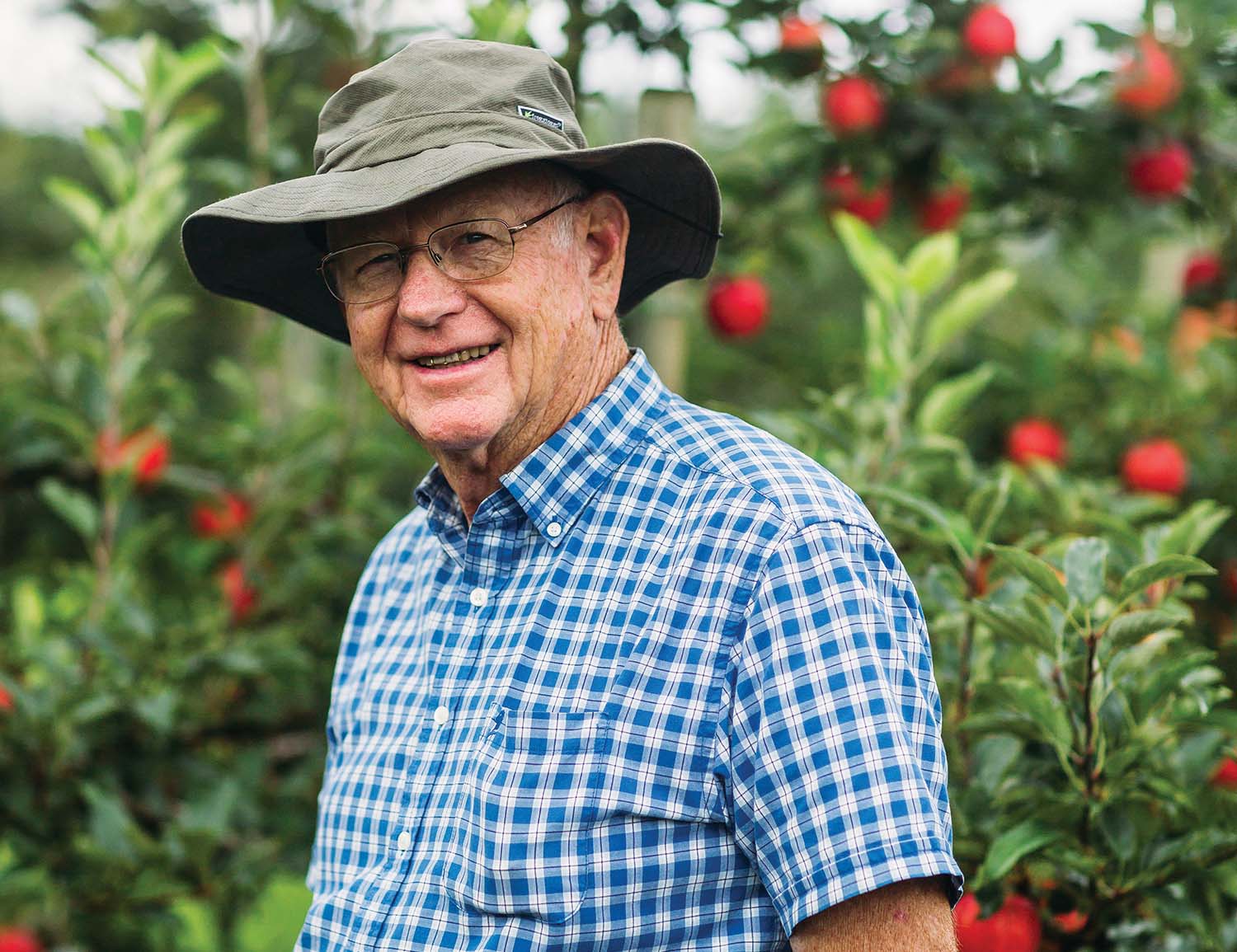
Tastes change, and orchard owners like Red Price try to offers apples for every whim. Photo by Tim Robison
The decisive victory at the Battle of Kings Mountain was twofold. The 1780 fray stroked patriots’ egos, bolstering morale following a series of defeats in the southern campaign. But it also, in a roundabout way, gave rise to Henderson County’s 5,000-plus-acre apple industry.
The 65-minute shootout left 290 loyalists dead and 163 wounded. British Major William Mills, son of Tory Ambrose Mills, was one of the latter. Though plagued by buck-and-ball ammo in the leg, he feigned greater ailments, playing dead amid the carnage. Later, he roamed to Sugarloaf Mountain, set down roots in tiny Fruitland, and cultivated the first apples to grace Henderson County soil.
His son-in-laws Asa and Samuel Edney carried the tradition into their namesake Edneyville community, though their scant yields strike a sharp contrast to modern bounties. Mottled and bitter, the apple varieties of yesterday would stand little chance in today’s produce section.
“They were utilitarian apples,” explains Marvin Owings, director of the Henderson County Cooperative Extension. He oversees the upkeep of a variety block on Chestnut Gap Road across from Saint Paul Mountain Vineyards.
Some cultivars there reflect current, more sophisticated tendencies in taste — intense Golden Russets, for instance — but of the 150 trees, many harken back to the cider strains that once dotted county orchards. Lacking refrigeration except for a domestic root cellar, old-timers fermented their harvests into intoxicating hooch or less spirited jam and sauce. The 200-year-old Gilpin variety of Virginia did well for grog, and the Wolf River apple for baking and canning, though neither were much to look at.
Neither was the Newtown Pippin, despite an impressive genealogy (Thomas Jefferson grew the squat, spotted fruits at Monticello). “They didn’t have the beautiful characteristics in terms of eye appeal,” Owings notes. He assumes trends shifted away from the antique and age-old on cosmetic grounds, though taste also played a part.
Many heritage varieties, such as the deep maroon Black Twig — said to be Andrew Jackson’s favorite — were rock hard and high in tannic acid. Despite its acrid taste, the Tennessee original kept till spring, making it one of the most popular dessert apples of the 19th century.
Still, the Stayman-Winesap eventually dominated the agricultural and culinary scene, says Owings. An excellent keeper , it has yellow-red flesh and boasts a sweet, wine-like flavor with a bitter finish.
“We believe it to be the finest apple that grows in America,” reads an 1845 South Carolina newspaper excerpt, taken from Creighton Lee Calhoun’s Old Southern Apples: A Comprehensive History and Description of Varieties for Collectors, Growers, and Fruit Enthusiasts. “If we were setting out an orchard of a thousand trees, eight hundred of them would be Winesaps.”
Other florid descriptions — “unrivaled,” “deservedly popular” — dot the article, words that hold true despite America’s later tendency toward everything honeyed and sweet.
In Hendersonville, the antique cultivar grows on a handful of farms, Mountain Fresh Orchards being one. Owner Donald “Red” Price rears two 50-tree rows worth of Winesaps each year. The result, he says, is a “good eatin’ apple,” less sour than a Granny Smith but still tart enough for preserves and buttery pies.
However, apple tastes change as swiftly as the weather. Today’s customers tend toward Honeycrisps and Pink Ladies above all, says Price.
“Winesaps are losing popularity fast,” he observes. Price established a small orchard while working at 7th Avenue’s Crystal Barber Shop. After 51 years trimming hair – a “long-enough time doing one thing” — he retired and now focuses on his crops, both heirloom and of-the-moment.
Rome and Red and Golden Delicious varieties took hold toward the mid 20th century, and Fruitland farmers gravitated toward commercial production, driving produce to Ottaray Cannery Company in Dana. In ’48, the Gerber baby-food plant moved into South Asheville, once again shocking the agricultural scene.
“The industry began looking for color, size, and appearance,” says Owings. “Farmers moved away from keeping ability and instead sought sweetness with a mild sourness.”
As palates shift and re-shift, morsels of history could be lost, except for the efforts of growers like Price.
“We sell some Staymans,” Price continues. “But nothing close to what we did some 20 or 30 years ago.”
Mountain Fresh Orchards has a roadside market located at 2887 Chimney Rock Rd. in Hendersonville. Call 828-685-7606 or visit www.mtnfreshorchards.com.
